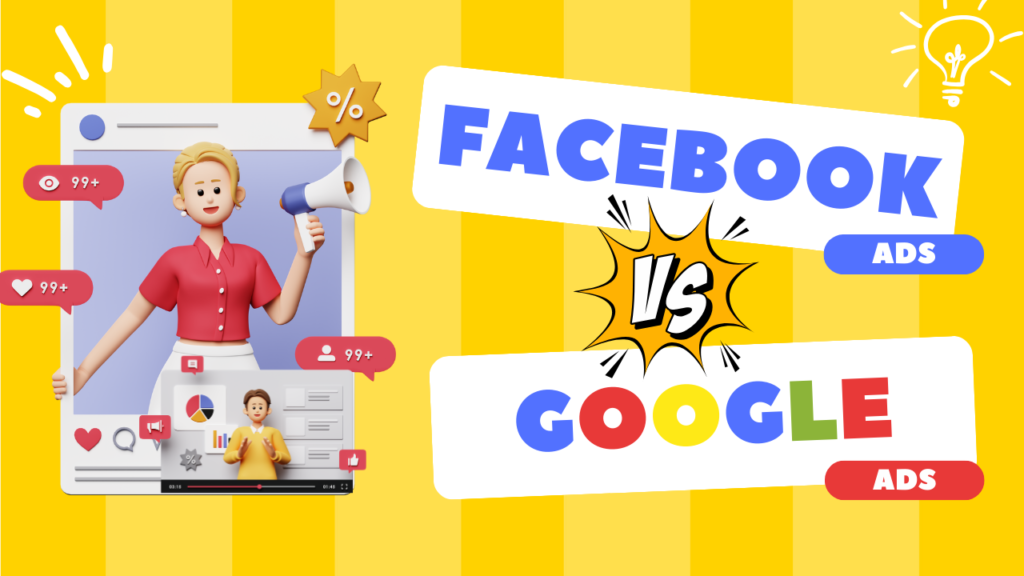Businesses must decide between Facebook Ads and Google Ads, two strong advertising platforms, in the ever-evolving world of digital marketing. There are benefits unique to each platform. One effective way to target consumers based on their interests and social behavior is through Facebook Ads, which increase brand recognition and encourages user engagement. While Google Ads want to instantly convert search traffic with strong intent, this is not the case.
Selecting the platform that will be most effective for your business requires an understanding of these differences and how they relate to your marketing goals. In this blog post, we will compare Facebook Ads vs Google Ads to help you make an informed choice and get the most out of your digital advertising strategy.
What are Facebook Ads?
Businesses may use Facebook Ads, a strong digital marketing tool, to develop focused advertising campaigns on the Facebook network. These advertisements may show up in users’ news feeds, on Facebook’s desktop site’s right-hand column, and on any of its partner websites or applications. Through the extensive data that Facebook gathers about its users, advertisers are able to target particular audiences according to their demographics, interests, habits, and other characteristics.
- Targeted Audience: Aim for particular demographics based on age, geography, hobbies, and lifestyle choices.
- Ad Formats: There are many other formats to choose from, such as slideshow, carousel, picture, and video ads.
- Performance Tracking: Use in-depth analytics and statistics to keep an eye on how effective your advertisements are.
- Budget Control: To efficiently control advertising expenses, establish daily or lifetime budgets.
Take note about using integration services like SaveMyLeads to increase the effectiveness of your Facebook advertisements. By automating the process of moving Facebook leads to your email marketing or CRM, this tool makes sure you can get in touch with potential clients as soon as possible. SaveMyLeads helps companies increase their marketing ROI and save time by simplifying lead handling.
Types of Facebook Ads
Before starting a Facebook ad campaign, it’s critical to comprehend the many kinds of Facebook ads and their benefits..
Facebook Ad Manager offers a wide range of ad choices, such as:
Image Ads:
Image ads are one of the most popular form of Facebook advertisements. A headline, description, and one image alone can pique your interest.
Given their simplicity, they are a great tool for advertising sales or particular products.
Video Ads:
Online video advertisements are becoming a more and more popular choice for companies because of their ease of use. They can show up as advertisements in longer Facebook videos or in stories and news feeds on the social media platform.
Facebook keeps track of how long people view videos, so you can use that data to build a retargeting audience. This is just one more way that Facebook can help.
Carousel Ads:
Carousel advertisements showcase a product or service with up to ten images or videos. This feature can be used to present a fresh update, highlight several products within a campaign, or highlight aspects of a product or service.
Users can add a link to each image in Facebook Ad Manager, making it possible for customers to find it from your website or business.
Slideshow Ads:
Similar to carousel ads, slideshow ads let you create several brief video commercials that aim to grab viewers’ attention.
The ability for businesses to use video commercials on a much smaller scale and budget is one of the notable benefits of slideshow ads. Slideshow ads are brief, affordable, and effective all at once.
Collection Ads:
This is a brand-new, mobile-only ad format. It’s made to make it simpler for customers to browse and buy your goods and services using a mobile device.
Viewers of your collection can peruse it without ever leaving the Facebook app.
Instant Experiences Ads:
Instant Experiences Ads, formerly known as Canvas, are a full-screen, mobile-focused ad style that loads much faster than mobile websites that aren’t on Facebook.
It Experiences allows users to view pictures and videos, explore carousels, and view goods that have been tagged in a single advertisement.
Lead Ads:
Lead advertising, which are optimized for mobile devices, are made to make it simple for consumers to provide you with their contact details without causing any inconvenience.
This adverts are useful for getting people to sign up for product trials or subscription collections.
Dynamic Ads:
Businesses can now market specific products to consumers who are likely to be interested in them thanks to dynamic advertisements. They are useful for following up with clients who have abandoned their carts.
Using dynamic advertisements does need having a Facebook Business Manager account.
Messenger Ads:
Facebook Messenger advertisements are a worthwhile choice, particularly in light of the platform’s enormous popularity.
It’s as easy as clicking a button in Facebook Ad Manager to place advertising on Messenger. After completed, advertisements will show up as a chat option, enabling prospective clients to get in touch with your company directly.
Stories Ads:
Stories ads are optimized for mobile, businesses can fully occupy the screen with their ads thanks to their full-screen vertical video format.
Similar to Instagram, Facebook Stories are gaining popularity as a medium for entertainment and offer a significant chance for ad placement.
Related Posts:
What are Google Ads?
Google’s advertising solution and program for businesses to advertise on its numerous products and wider search network is called Google Ads (formerly known as Google AdWords). Google and YouTube are the two biggest search engines in the world, and you may advertise to them through the ad platform.
The program is only an option if you want to promote on Google’s other products, such Gmail. If you’re not using search and other forms of advertising in your business, your firm will suffer. There are more adverts on Google Search and its other domains than ever before in a variety of ways.
Types of Google Ads
To assist businesses in successfully reaching their target audience, Google Ads provides a variety of ad formats. These are the primary categories:
Search Ads
When consumers search for particular terms, these text adverts show up on Google search results pages. Since they target those who are actively looking for information connected to your products or services, they are quite successful at collecting user intent.
Display Ads
These are visual advertisements that can be found on millions of websites, applications, and Google-owned domains like Gmail and YouTube as part of the Google Display Network. Display advertisements can reach a wider audience and increase brand exposure by using interactive elements, text, and images.
Video Ads
These advertisements can be seen on the Google Display Network as well as YouTube. With interesting video content, video commercials can be used to market goods, services, or brand messaging. They can even be set to play automatically.
Shopping Ads
These product-based advertisements appear on the Google Shopping tab and search results pages. They include a picture of the goods, the title, the price, the store name, and more. When it comes to e-commerce companies trying to display their products right in search results, shopping advertising work incredibly well.
App Ads
These advertisements advertise mobile apps on the Google Display Network, YouTube, Play, Google Search, and Discover. By encouraging app-specific actions like in-app purchases and registrations, they aid in increasing app installations and engagement.
Smart Ads
Clever campaigns use Google’s machine learning to automate and improve ad performance. Google manages the targeting, bidding, and ad placements to optimize results depending on your objectives after you supply the ad information.
Local Ads
These advertisements market your company to clients in the area. They show up on YouTube, Maps, Google Display Network, and Google Search. For companies with physical locations looking to increase foot traffic and local sales, local advertisements are perfect.
Best For:
- Companies hoping to attract customers who are actively looking for their goods or services and convert them.
- Businesses preferred quantitative ROI and immediate reaction.
- Local companies trying to attract customers to their physical sites.
Which to Choose (Facebook Ads and Google Ads)
- Consider Your Goals: Facebook Ads may be a better option if you want to interact with users based on their interests or increase brand awareness. Google Ads can be the best option if your main goals are to drive direct conversions and capture intent.
- Budget: Although they use distinct bidding processes, both platforms might be useful in a variety of budgetary constraints. Because Google Ads use intent-based targeting, CPC (Cost Per Click) usually runs higher
- Audience: Consider the places and times that your target spends using your product or service. Google focuses on capturing active search intent, but Facebook is more concerned with interaction and discovery.
Conclusion
Your marketing objectives will determine which Facebook Ads and Google Ads are best for you. Facebook Ads and Google Ads each offer unique advantages. Facebook Ads are perfect for increasing brand recognition and fostering user interaction since they allow for precise targeting based on demographics and interests. They are excellent for visually stimulating campaigns and provide a variety of forms. Conversely, Google Ads are excellent at attracting highly-intent searchers, which makes them ideal for generating conversions and obtaining quantifiable return on investment.
Facebook Ads and Google Ads provide a wide audience across Google Search, YouTube, and other platforms by focusing on those who are actively looking for particular goods or services. Combining the two platforms can often optimize your digital advertising approach by utilizing each one’s advantages to help your company expand.

